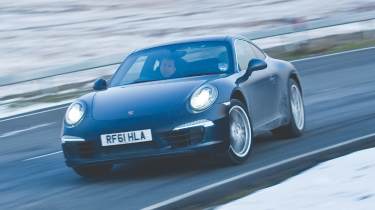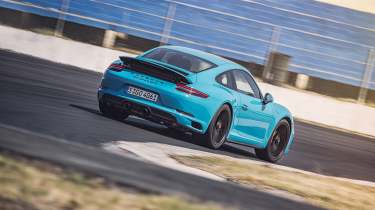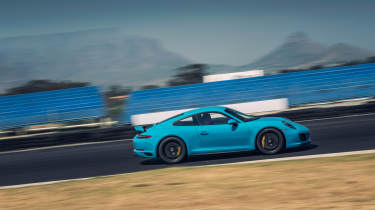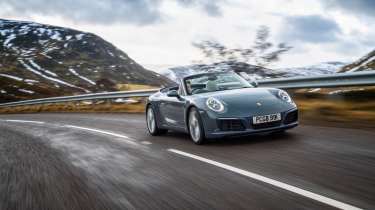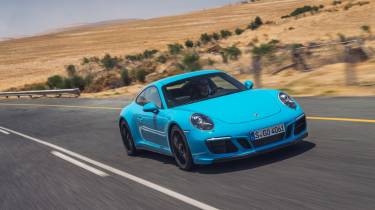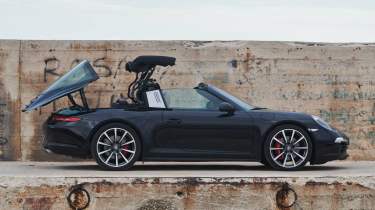Used Porsche 911 (991, 2011 - 2018) review – should you buy the unloved 911?
For better or worse, the 991 was a huge moment of change for the Porsche 911, as it passed the half-century mark. We look back at the black sheep of the 911 family
The 991 represented probably, for better or worse, the second biggest moment of change in the history of the Porsche 911, after the move to water cooling and the 996 platform. The 991 is for enthusiasts the unloved generation of 911 – a larger, less involving, less tactile 911 that strayed the furthest from what made the originals so beloved.
Arriving in 2011, the 991 was the first wholesale change to the 911 Carrera’s body in white for 14 years. The result was the largest 911 yet, the 991 being 56mm longer, with a 100mm longer wheelbase. The front and rear overhangs were also reduced by 32mm and 12mm respectively. On the plus side, thanks to careful material use, the 991 Carrera did drop in weight in its most basic forms and add rigidity, by comparison to the 997, to under 1400kg. Even so, bigger brakes with the option of ceramics ensured improved stopping power.
The overall look is smoother, sleeker, slipperier and more modern than the 997 it replaced. The front features bulbous swept-back lights and dayrunners flanking the side vents. At the rear, a taller tail is punctuated by sharp blade-like lights, topped with a much wider active wing.
More reviews
Group tests
In-depth reviews
Long term tests
Reviews
All change inside, too. Not only did the extra wheelbase allow the 991 to be the most spacious 911 yet, but the 991’s cabin was a huge step up from Porsche in terms of fit, finish, material appointment and build quality. Some 911 hallmarks like the five-pod instrument cluster remained, but the 991 incorporated a raised central tunnel for a more cockpit-like, driver-focused feel.
Under the skin it was all change too, with a new, cleaner, more powerful and more efficient range of direct fuel injection engines and a new seven-speed manual transmission. The 991’s new transaxle gearbox design allowed the wheels to be mounted 76mm further rearward towards the engine, greatly benefitting weight distribution.
Other new tech on the Carrera S included Porsche Dynamic Chassis Control, an active roll stabilisation system using dynamic ARBs. Joining also as an option on the Carrera S was Porsche’s active rear steering system, for improved agility and stability. Adaptive dampers, or Porsche Adaptive Suspension Management in Stuttgart speak, was nothing new, refined and revised for the 991 911.
Manual cars were equipped with Porsche Torque Vectoring and a mechanical locking rear diff; PDK cars got PTV Plus with an electronically controlled diff. The most controversial change to the 991, however, was the new weight-adjustable electric power steering, which took the place of the hydraulically-assisted rack of the 996 and 997.
Porsche 991 engines – from direct injection to turbocharging
While the ‘Mezger’ engine departed with the second-generation 997 911, it’s the 991 that will be remembered as the 911 that underwent the most dramatic of heart transplants.
It first arrived with two naturally-aspirated direct fuel injection flat sixes – a 3.4-litre for the standard 991 Carrera, and a 3.8-litre for the Carrera S. A version of the latter also made its way into the 981 Porsche Cayman GT4. The 3.4, while smaller than the 3.6 of the last 997 Carrera, matched it for power with 345bhp. Meanwhile the Carrera S’s 3.8 jumped to 395bhp – 20 more than the last 997 Carrera S and just 7bhp shy of the 997 Carrera GTS.
The 911 50th Anniversary Edition of 2014 used the Carrera S as its basis, with a Powerkit option to boost power to 424bhp. This engine latterly made its way into first-generation 991 911 GTS models. Acceleration to 62mph for the 991.1 911 takes between 5.2 seconds for a base Targa 4 manual and 4 seconds flat for a Carrera 4 GTS PDK.
The last of the 991.1s would also turn out to be the last naturally-aspirated 911 to emerge from anywhere other than Porsche’s GT department. For the 991 gen 2 of 2016, another new range of engines arrived, all versions of the same basic 3-litre twin-turbo flat-six, to an end of increasing performance and improving emissions.
Power and torque were boosted, as you might imagine – 365bhp for the Carrera and Carrera T (a new addition at the time), 414bhp for the Carrera S and 444bhp for the Carrera GTS. The mapping did however give a sense of linear progression rather than a crescendous surge as boost comes on, with peak power only arriving 900rpm sooner on the turbocharged engines. Acceleration at its quickest in a 991.2 ranges from 4.7sec for a manual Carrera 4 Cabriolet, to 3.6sec for a PDK Carrera 4 GTS – quicker than the Carrera GT hypercar. Emissions dropped reasonably substantially too, to below between 169 and 220g/km.
Porsche 911 (991) specs
| Year | Model | Engine | Power (bhp) | Torque (lb ft) |
|---|---|---|---|---|
| 2011 | 991 Carrera | 3.4-litre flat-six | 345 @ 7400rpm | 288 @ 5600rpm |
| 2011 | 991 Carrera S | 3.8-litre flat-six | 395 @ 7400rpm | 325 @ 5600rpm |
| 2014 | 991 Carrera GTS | 3.8-litre flat-six | 424 @ 7400rpm | 325 @ 5600rpm |
| 2015 | 991.2 Carrera | 3.0-litre flat-six twin-turbo | 365 @ 6500rpm | 332 @ 1700-5000rpm |
| 2015 | 991.2 Carrera S | 3.0-litre flat-six twin-turbo | 414 @ 6500rpm | 369 @ 1700-5000rpm |
| 2016 | 991.2 Carrera GTS | 3.0-litre flat-six twin-turbo | 444 @ 6500rpm | 406 @ 2150-5000rpm |
Porsche 991 Targa and Cabriolet
There are two points of note beyond the usual ‘these are the least focused versions you can get’ that’s levied on every 911 Targa and Cabriolet, for the 991 generation. Firstly, from a technical perspective, open top 991s are much less compromised than the 997s and 996s that came before them. A 991 Cabriolet is 60kg lighter, relatively speaking than the 997 Cabriolet it replaced. The aluminium-steel structure of the 991 was optimised from the beginning, for conversion into the cabriolet. The change isn’t undetectable when the roof comes off and Cabs are still heavier – around 70kg compared to an equivalent coupe – but they’re not the flawed devices pop-top 911s once were.
When it comes to the 991 Targa, the most dramatic difference is in the design, with the old glass ‘dome’ and silver rollover hoop design making a return. A visually distinctive design it is but the 991 Targa, as ever, is the heaviest of the range, adding 110kg compared to an equivalent Carrera 4 Coupe. A good amount of that weight is also relatively high up, thanks to the roof design, so it also has the highest centre of gravity of any 991, which does manifest in how it drives. Be aware too that you can’t operate the roof of the Targa on the move like you can the Coupe, as the rear lights are momentarily obscured in the process. Also, there’s no rear-drive option for a Targa.
Porsche 991 Carrera 4
Four-wheel drive was no longer the barrier to fun in a 911 that it once was, per the revised 997.2 Carrera 4 family and their electronic Porsche Traction Management system. Further pollution of the steering feel that usually comes with sending drive to the fronts wouldn’t be welcome but happily, in the 991, there’s not much to pollute as it is. Perversely, the Carrera 4 can be a better steer than the rear-driven cars, albeit with the extra traction adding straight-laced composure.
It’s also worth noting that the 991 is the last 911 to date to separate the rear- and four-wheel-driven 911s in terms of their body. All 991s that send drive to the front wheels are wider at the rear by 44mm. Overall weight gain for any 911 that sends power to the front is 50kg heavier compared to the equivalent rear-driven car.
Porsche 991 Carrera GTS – the sweet spot?
As in the final 997, the GTS is the ‘most’ 991 you can get without buying a Turbo or GT3 variant. In both 991.1 and 991.2 guises, the added visual attitude of the widened rear track, blacked-out badging, RS Spyder-style wheels and endless exhaust crackles define the GTS style, stance and attitude. The option of 918 Spyder-esque bucket seats and sticky tyres add to the sense that the GTS is a 991 that’s more serious about performance, yes, but also driving sensation.
In the end the GTS had become the car we’d always hoped was hiding within the standard Carrera. The GTS could be had in all sorts of flavours too – as a coupe, a Targa or a cabriolet, with PDK or a seven-speed manual, with four- or two-wheel drive.
Porsche 911 Carrera T – the ‘less is more’ 991 is also the rarest
A new addition to the 911 lineup (not that there weren’t enough already) for the 991.2 was the Carrera T, a back-to-basics approach to a sporting 911, marrying the basic power and footprint of a standard Carrera, with the option of extreme lightweighting, from GT3 carbon bucket seats and fabric door pulls, to the wholesale deletion of the infotainment system.
At the time we craved yet more commitment and focus from the T than Porsche was willing to bestow upon it. In hindsight, it’s easy to understand why pushing the T still further in a ‘budget GT3’ direction might not be popular behind the scenes in Stuttgart. Indisputable is the fact that the 991 Carrera T is the rarest 991, arriving as it did so late into the car’s life, with very little awareness of its purpose and billing at the time.
What we said
evo has driven every version of the 991 over the years. Here are excerpts from those encounters, with increased ability but reduced interactivity a common theme.
Porsche 991.1 Carrera manual first drive, 2013 – David Vivian
‘Fundamentally, you want your 911 to go, steer, grip and stop in a properly stimulating manner. And in three out of four of these disciplines, the entry-level 3.4, manual 991 is simply a better car than the base level 997 it replaces. The acoustically-enhanced soundtrack is gruffer and more urgent, roll-on pace slightly swifter, the front-end grip and conviction generated by the wider track notably stronger and the stoppers marginally more incredible. The 991 throws in some extras, too: a more comfortable ride, less road roar, better cruising refinement and a properly designed, exceptionally well built and finished cabin.
‘The electric steering only just wings it. Perhaps think of it as an MP3 version of the 997’s hydraulic set up. It gives the impression of having been tailored to snap-fit into the broader repertoire of the new car with its more nailed and composed front end and a torque vectoring system you can actually feel pointing you towards the apex when you're pushing on and haven’t turned the stability and traction programmes off. But it is accurate and it does have a helpful degree of feedback – just not as much or as textured in nature as a 997 GT3’s. Even if the 7-speed ‘box isn’t the slickest ever to grace a 911, it does provide another layer of rewarding interaction. In a 911, that can only be a good thing.’
Porsche 991.1 Carrera review, 2013 – Richard Meaden
‘Seeing the 991 amongst its ancestors is both reassuring and alarming: reassuring because you can clearly see the bloodline in its stance and profile, but alarming because it looks so much bigger than the others. It’s as though someone at Weissach erroneously pressed 110 per cent on the photocopier before sending the blueprints to the manufacturing department.
‘It’s miraculously capable – engaging and enjoyable too in absolute basic specification – but despite the searing corner speed and seductive quality, there’s still a sense that something’s missing. That something is the subtle flow of information that connects you to a 911 as completely at walking pace as it does at warp speed. In the 991 every imperfection has been systematically ironed out, those few remaining dynamic wrinkles given a big shot of Botox to smooth things over. Like Amanda Holden, it lacks expression.’
Porsche 991.1 Targa 4 review, 2014 – Adam Towler
‘Both Targa models get a Sport button to add weight to the steering and sharpen the throttle response, but only the Targa 4S gets Porsche Active Suspension Management, which can adapt to suit the road surface, as standard. Similarly, Porsche Torque Vectoring, which uses the inside rear brake to pivot the car into turns to good effect, is standard only on the Targa 4S and optional on the Targa 4.
‘One option that is exclusive to the higher-powered model, Porsche Dynamic Chassis Control, uses variable anti-roll bars to cut body roll during hard cornering. It’s a clever system, but since roll is how the driver feels the loading of the chassis in corners, it is best avoided.
‘On or around the limits of its capabilities, the Targa is so composed, unflustered and, in a sense, lifeless that it just doesn’t engage and reward in the manner that the two-wheel drive coupe can.
Porsche 991.1 Carrera 4 review, 2014 – Adam Towler
‘There’s a little more weight to the steering from the moment you begin to turn, and grip levels are immense. Say what you like about the steering, but you never find yourself making a second correction once you’ve set your course.
‘Fans of old 911s might be nonplussed by the devastating, vice-free (or character-free?) competence, but subjectively there feels slightly more to engage with in this car than the rear-wheel drive Carrera.
Porsche 991.2 Carrera S, evo 218, 2015 – Dan Prosser
‘I had hoped this updated 911’s steering would have benefited from following in the tracks of the GT3 and GT3 RS, both of which steer with so much more of the texture and feel of previous generations. Unfortunately, the new car’s helm is still pretty untalkative.
‘I love the sensation of a steering system loading up just as the car squats down in hard cornering, and that’s not something this 911’s rack ever does, though it is very direct and keenly weighted.’
Porsche 991.2 Carrera S Cabriolet review, 2016 – Stuart Gallagher
‘This series of 911 Cabriolet has better body control than any iteration that has gone before. Scuttle shake is all but eliminated, there’s only the slightest hint of flex through the shell when you hit a vicious bump or series of undulations, and it’s a far easier car to balance with throttle and steering inputs than before.'
Porsche 991.2 Carrera GTS review, 2017 – Dan Prosser
‘It’s difficult to pin down exactly what it is that makes this car more fun to drive than a Carrera S since the chassis settings are more or less unchanged. The wider rear track must count for something, but more likely it’s the optional Corsa tyres that make the difference, this being one of the rare occasions where a stickier, more robust tyre actually makes the car more enjoyable to drive – in the dry, at least. It’s also very possible that by ramping up the mechanical grip the steering and the chassis as a whole have become more communicative and easier to read.
‘That means you feel so much more involved in the process of picking apart of good stretch of road. Whereas certain Carreras can be aloof and distant even when driven quickly, this GTS is with you every step of the way, whether you’re stroking it along or scaring yourself silly. The manual gearshift is fantastic and the steering is very good for an electric system, too.
‘It is true that this turbocharged 3-litre engine doesn’t get close to troubling the previous normally-aspirated unit for soundtrack and delivery, but it’s also true that the six-pot is one of the most linear and responsive turbo engines on the planet. It revs well to the limiter at 7400rpm and it delivers massive overtaking punch, too.’ – Dan Prosser, 2017
What to pay and buying guide
With the amount of trim and performance options there are, over the seven years they were on sale, 991 Carrera prices vary dramatically. At the time of writing, a 2011 991 Carrera 3.4 PDK with 95,000 miles was available for just under £32k. By contrast, a 2015 991.1 Targa 4 GTS with 3090 miles was up for £94k – more than a similarly aged GT3.
As with all 911s, manuals and rear-driven cars carry a premium. Although we’ve yet to see earlier NA cars come out in favour over a slightly newer turbocharged Carrera, it’ll be interesting to observe how those values evolve.
As ever, you’ll want a car that’s been taken care of, with good MOT history, a history of maintenance with official Porsche centres or specialists and a few problem areas covered off. The condition of the tyres and brakes will be an indicator too of what TLC the car has received over its years and conversely, could be a good haggling point.
Happily, there are plenty of specialists that now know these cars inside out, that are all too happy to assist in finding the right car – that means helping find a healthy car, too. Whether from a specialist or a dealer, you’ll even be able to check the engine’s rev history.
Look out for tired, leaky dampers and tired engine and transmission mounts – dynamic engine mounts are a known failure point and expensive to replace. Smell and feel for damp in the carpets, as this could be a sign of a leaking air conditioning unit. One to sort quickly, or you risk expensive electrical issues down the road.
The seven-speed manual, while not loved when new, is still a useful point of interaction in a generation of 911 that’s a little short on it. It’s also more dependable than the dual-clutcher, which while great when working, can be a problem child, to the point of requiring a wholesale replacement if you get a bad one.
